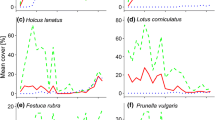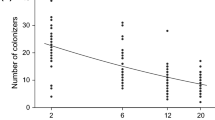Abstract
Succession is one of the most studied processes in ecology and succession theory provides strong predictability. However, few attempts have been made to influence the course of succession thereby testing the hypothesis that passing through one stage is essential before entering the next one. At each stage of succession ecosystem processes may be affected by the diversity of species present, but there is little empirical evidence showing that plant species diversity may affect succession. On ex-arable land, a major constraint of vegetation succession is the dominance of perennial early-successional (arable weed) species. Our aim was to change the initial vegetation succession by the direct sowing of later-successional plant species. The hypothesis was tested that a diverse plant species mixture would be more successful in weed suppression than species-poor mixtures. In order to provide a robust test including a wide range of environmental conditions and plant species, experiments were carried out at five sites across Europe. At each site, an identical experiment was set up, albeit that the plant species composition of the sown mixtures differed from site to site. Results of the 2-year study showed that diverse plant species mixtures were more effective at reducing the number of natural colonisers (mainly weeds from the seed bank) than the average low-diversity treatment. However, the effect of the low-diversity treatment depended on the composition of the species mixture. Thus, the effect of enhanced species diversity strongly depended on the species composition of the low-diversity treatments used for comparison. The effects of high-diversity plant species mixtures on weed suppression differed between sites. Low-productivity sites gave the weakest response to the diversity treatments. These differences among sites did not change the general pattern. The present results have implications for understanding biological invasions. It has been hypothesised that alien species are more likely to invade species-poor communities than communities with high diversity. However, our results show that the identity of the local species matters. This may explain, at least partly, controversial results of studies on the relation between local diversity and the probability of being invaded by aliens.
Similar content being viewed by others
Author information
Authors and Affiliations
Additional information
Received: 13 July 1999 / Accepted: 4 February 2000
Rights and permissions
About this article
Cite this article
Van der Putten, W., Mortimer, S., Hedlund, K. et al. Plant species diversity as a driver of early succession in abandoned fields: a multi-site approach. Oecologia 124, 91–99 (2000). https://doi.org/10.1007/s004420050028
Issue Date:
DOI: https://doi.org/10.1007/s004420050028




